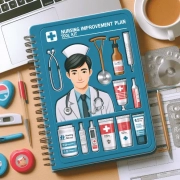NURS FPX 4020 Improvement Plan Tool Kit Medication Error Example Essay
 NURS FPX Capella 4020 Assessment 4: Improvement Plan Toolkit – Medication Error Assignment
NURS FPX Capella 4020 Assessment 4: Improvement Plan Toolkit – Medication Error Assignment
Assignment Brief: NURS FPX 4020 Improvement Plan Tool Kit Medication Error Assignment
Course: NURS FPX 4020 Improving Quality of Care and Patient Safety
Assignment Title: Assessment 4: Improvement Plan Toolkit – Medication Error Assignment
Overview:
In this assignment, students are tasked with creating a toolkit to improve patient safety by addressing medication errors in healthcare settings. The goal is to understand the impact of various factors, including technology, work environment, and communication, on medication errors. Through analyzing academic articles, students will gather insights into the role of electronic health records, the quality of nursing staff, the impact of work environments, physician burnout, and the concerns of healthcare stakeholders in patient safety. The toolkit should offer practical strategies to reduce medication errors and enhance patient safety.
Understanding Assignment Objectives:
The primary objectives of this assignment are to:
- Explore the different aspects of medication errors in healthcare settings.
- Analyze the influence of electronic health records, nursing staff quality, work environments, physician burnout, and healthcare stakeholders on patient safety.
- Develop a practical improvement plan toolkit based on insights gained from academic articles.
- Propose strategies to reduce medication errors and enhance patient safety.
The Student’s Role:
As a student undertaking this assignment, your role is to explore various academic articles and extract key insights related to medication errors and patient safety. Understand the impact of electronic health records, the quality of nursing staff, work environments, physician burnout, and the concerns of healthcare stakeholders. Synthesize this information to propose practical strategies within an improvement plan toolkit. Your analysis should reflect a deep understanding of the information presented in the articles, allowing you to make informed recommendations for reducing medication errors.
NURS FPX 4020 Improvement Plan Tool Kit Medication Error Example Essay
Introduction
Healthcare professionals, including nurses, greatly benefit from having an improvement plan toolkit. This toolkit serves as a valuable resource for gaining knowledge and reflecting on past errors. Communication and information sharing play a crucial role in medical practices, allowing professionals to exchange knowledge and methodologies. This sharing process helps individuals recognize their shortcomings and provides insights from peers, contributing to continuous improvement. The comprehensive toolkit is specifically designed to support nurses in reading and acquiring essential knowledge, ultimately enhancing their skills and refining their practice. Unfortunately, medication errors are prevalent in the medical field. Governments and researchers globally have extensively studied the causes and effects of these errors. In response, government departments have developed policies and guidelines aimed at reporting, reducing, and preventing such errors. Researchers have conducted experiments and reported on the various causes and influencing factors of medication errors. This collective effort contributes to the ongoing improvement of healthcare practices and emphasizes the importance of learning from mistakes to enhance patient safety.
Organization Policies and Guidelines for Medication Safety
Billstein-Leber, M., Carrillo, C. J. D., Cassano, A. T., Moline, K., & Robertson, J. J. (2018). ASHP guidelines on preventing medication errors in hospitals. American Journal of Health-System Pharmacy, 75(19), 1493-1517. https://doi.org/10.2146/ajhp170811
In the article titled by Billstein-Leber et al. (2018), the focus is on outlining the goals of medication treatment to achieve specific therapeutic outcomes, thereby enhancing the quality of life for patients and minimizing risks. The use of drugs, whether prescription or nonprescription, poses inherent hazards, both recognized and unknown.
The article categorizes pharmaceutical problems as any avoidable incidents that could result in incorrect medicine usage or harm to the patient while the medications are under the responsibility of a healthcare practitioner, patient, or client. A comprehensive overview is provided on the guidelines established by the American Society of Health-System Pharmacists (ASHP). These guidelines are crucial for healthcare professionals in preventing and addressing prescription errors.
The ASHP guidelines, detailed in the article, offer a structured approach for healthcare practitioners to follow in the event of a prescription error. This structured approach ensures the safety not only of the patient but also of their relatives and the healthcare provider. The guidelines encompass 11 key recommendations, accompanied by specific strategies tailored for healthcare providers involved in the administration of medications.
Reporting Medication Errors: Understanding Factors and Promoting Accountability
Hammoudi, B. M., Ismaile, S., & Abu Yahya, O. (2018). Factors associated with medication administration errors and why nurses fail to report them. Scandinavian Journal of Caring Sciences, 32(3), 1038-1046. https://doi.org/10.1111/scs.12546
In the article titled by Hammoudi et al. (2018), the focus is on shedding light on the intricacies of medication administration errors and the reasons why nurses may hesitate to report them. The study recognizes the uniqueness of each incident but emphasizes the presence of commonalities and patterns in risk sources that could go unnoticed without proper documentation and examination.
The article stresses the critical role of reporting in identifying patient safety issues, acknowledging that reporting alone may not offer a comprehensive view of all risk sources and adverse reactions. The authors propose the incorporation of solid safety programs in healthcare settings, highlighting key aspects such as shared responsibility among employees for their safety and that of their colleagues and patients. They emphasize prioritizing safety over operational and financial objectives and fostering communication to address safety concerns, thereby contributing to institutional resilience.
The research paper provides an extensive list of factors associated with medication errors and delves into the reasons behind nurses’ reluctance to report such incidents. By studying this paper, nurses can gain insights into the factors influencing non-reporting and understand the potential consequences they might face. This knowledge is crucial for fostering a culture of accountability, empowering nurses to confidently report errors without fear of blame, ultimately contributing to enhanced patient safety.
Technology and Tools
Baumann, L. A., Baker, J., & Elshaug, A. G. (2018). The impact of electronic health record systems on clinical documentation times: a systematic review. Health Policy, 122(8), 827-836. [DOI: 10.1016/j.healthpol.2018.05.014]
In the contemporary healthcare landscape, the integration of Electronic Health Record (EHR) systems has induced transformative shifts, particularly within clinical documentation practices. Conducting a systematic review, Baumann, Baker, and Elshaug (2018) explore the implications of EHR systems on clinical documentation times, demonstrating numerous advantages they bring forth.
This study takes a look at the pivotal role of hospital personnel as significant healthcare assets, emphasizing their substantial contribution to care quality and the realization of public healthcare objectives. Recognizing personnel as vital components, the authors underscore the imperative to optimize their talents through efficient time utilization, ensuring the delivery of optimal patient care. Over the past two decades, a surge in paperwork and repetitive tasks for hospital physicians has encroached upon the time earmarked for direct patient care, thereby fostering heightened schedules, augmented dissatisfaction, and instances of burnout among personnel.
The introduction of EHR systems emerges as a promising solution to these challenges, with the transition from traditional paper-based methods expected to afford healthcare professionals more time for direct patient care by mitigating burdensome paperwork. Additionally, EHR systems facilitate streamlined data sharing among clinical personnel, presenting a potential remedy for the time constraints associated with traditional documentation practices.
A notable advantage intrinsic to EHR systems lies in the integration of computer-based decision support systems, proven to enhance patient safety by mitigating the incidence of prescription and reporting errors. These systems functionally provide timely notifications to healthcare staff concerning potential correlations, drug interactions, and necessary dose adjustments—proactive measures that surpass the capabilities of human practitioners, contributing to a safer medication administration process.
Moreover, EHR devices augment the flow of information and awareness within healthcare settings. Equipped with real-time inspections and surveillance mechanisms, these systems promptly identify and address issues, thereby fostering a more responsive and vigilant healthcare environment. The multifaceted benefits outlined in this systematic review position EHR systems as integral components in the ongoing evolution of healthcare practices, warranting further exploration and implementation.
Costa, J., Martins de Assis, J., Melo, M., Xavier, S., Melo, G., & Costa, I. (2017). Technologies Involved in the Promotion of Patient Safety in the Medication Process: An Integrative Review. Cogitare Enfermagem, 22(2), [DOI: https://doi.org/10.5380/ce.v22i4]
The study explores the impact of medical technologies on patient safety, with a focus on electronic health records (EHR) and mobile technologies. These advancements not only benefit patients in their treatment but also support medical professionals, including nurses. Nurses, who actively participate in documenting treatments and administering medications, face the challenge of managing multiple patients with diverse medical conditions and medications.
Given the complexity of handling various medicines for different patients, it becomes crucial to streamline the documentation process to prevent nurse burnout. The study emphasizes the need to reduce the duration of documentation, allowing nurses to take adequate rest. Maintaining foolproof records for each patient is highlighted as essential to prevent medication errors, ensuring that patients receive the correct medicines.
The utilization and understanding of EHR play a significant role in supporting nurses in their responsibilities. The study underscores the positive impact of EHR on enhancing nursing practices and contributing to patient safety during the medication process.
Talyor, Z. B. (2019). Eliminating Medication Errors in Nursing Practice with an Innovative Quality Improvement Tool Proposal. https://commons.lib.niu.edu/handle/10843/21691
Taylor proposes an innovative tool designed to reduce medication errors among nurses by systematically guiding them through the five principles of medication administration. The priority for nurses is delivering optimal patient healthcare to achieve the highest possible outcomes. Medication prescription mistakes pose a common challenge, defined as failures in executing any of the five rights to administration. These errors, encompassing method, dose, medicine, patient, or timing, can lead to severe side effects and harm or death. Addressing the multifaceted causes of prescription errors, nurses can utilize insights from literature to develop a quality and safety improvement strategy, aiming to eliminate medication mistakes.
Krick, T., Huter, K., Domhoff, D., Schmidt, A., Rothgang, H., Wolf-Ostermann, K. (2019). Digital technology and nursing care: a scoping review on acceptance, effectiveness, and efficiency studies of informal and formal care technologies. BMC Health Serv Res, 19(1), 400. https://doi.org/10.1186/s12913-019-4238-3
The ongoing discourse on technology as potential solutions to challenges like the shortage of qualified personnel and the increasing demand for long-term care underscores the importance of exploring the availability, use, and advantages of digital technologies in nursing care. This study aims to describe the landscape of digital technologies in both formal and informal care, previously examined for acceptability, efficiency, and effectiveness (AEE). The research delves into the methods employed, target locations, populations, and supporting fields.
The focus of this study is on guiding nurses in leveraging digital technology effectively. With these technological solutions becoming more prevalent in the medical field, nurses are encouraged to enhance their knowledge and skills in utilizing these tools. The research is supportive of nurses being proficient users of digital technologies, emphasizing their role in increasing patient safety and satisfaction throughout the treatment process. These technologies facilitate communication among healthcare staff and patients, empowering nurses to make informed decisions beneficial to patient care.
Aguirre, R. R., Suarez, O., Fuentes, M., Sanchez-Gonzalez, M. A. (2019). Electronic Health Record Implementation: A Review of Resources and Tools. Cureus, 11(9), e5649. https://doi.org/10.7759/cureus.5649
This article provides a comprehensive review of resources and tools for the implementation of Electronic Health Records (EHR) in healthcare settings. Acknowledging the challenges involved in adopting EHR, the study emphasizes the need for thorough preparation to avoid mistakes. The responsibility lies in evaluating selection criteria and deployment strategies, ensuring portability, privacy, accessibility, and safety of patient healthcare information records. The implementation strategy involves examining existing institutional processes, considering departmental requirements, and preferences for the EHR system. The article emphasizes the role of EHR in improving workflow productivity and enhancing patient care safety. To ensure efficiency, the provider’s team is advised to follow a set of measures for effective deployment and administration of the EHR system. A testing strategy is recommended before full deployment to identify and address potential staff misunderstandings, contributing to a successful EHR implementation.
Stakeholders in Medication Errors
Di Simone, E., Fabbian, F., Giannetta, N., Dionisi, S., Renzi, E., Cappadona, R., & Manfredini, R. (2020). Risk of medication errors and nurses’ quality of sleep: a national cross-sectional web survey study. Eur Rev Med Pharmacol Sci, 24(12), 7058-7062. DOI: 10.26355/eurrev_202006_21699
The study conducted by Di Simone et al. (2020) looks into the critical connection between nurses’ quality of sleep and the risk of medication errors. Despite nurses’ subjective perceptions of having experienced a restful night, the research highlights the significant impact of inadequate rest on their overall performance. The study emphasizes the essential link between factors such as working shifts, poor sleeping conditions, and the heightened risk of medical errors. The findings stress the importance of recognizing this relationship within the healthcare community.
The web survey conducted as part of this study serves as a valuable tool for gathering information on the likelihood of medical errors associated with sleep quality. The study underscores the necessity for healthcare institutions to actively support and encourage such research initiatives. By acknowledging the impact of sleep on performance and patient safety, institutions can take a more proactive stance in implementing measures to ensure nurses have adequate rest during their shifts. This approach can contribute significantly to reducing the chances of errors and promoting a safer healthcare environment.
Kieft, R.A., de Brouwer, B.B., Francke, A.L. and Delnoij, D.M. (2014). How nurses and their work environment affect patient experiences of the quality of care: a qualitative study. BMC Health Services Research, 14(1), pp.1-10. DOI: 10.1186/1472-6963-14-249
Kieft et al. (2014) conducted a qualitative study exploring the impact of nurses and their work environment on patient experiences of healthcare quality. Healthcare organizations routinely monitor patient experiences to assess and improve the overall quality of services. Given the significant amount of time nurses spend with patients, their influence on patient satisfaction is crucial. The primary objective of the study was to understand how Dutch nurses perceive their work environment in relation to creating positive patient experiences.
Nurses identified several key components that they believed would enhance patient perspectives on the quality of nursing care. These included the skills and knowledge of nursing staff, cooperative work interactions, autonomous nursing practice, access to adequate resources, command over nursing practice, management support, and the promotion of a patient-centered culture. Despite recognizing these factors as crucial, nurses also highlighted impediments such as cost-effectiveness policies and transparency goals for external accountability.
The study emphasized the nurses’ perception of a substantial administrative workload and the pressure to enhance productivity. Nurses expressed concern that these characteristics might not contribute to improved patient perceptions of nursing care quality. The findings underscored the multifaceted nature of patients’ perceptions of care quality, influenced by various factors.
Volunteers in the study believed that integrating these identified components into routine nursing practice could lead to better patient outcomes. However, nurses faced challenges in balancing cost-effectiveness and responsibility while striving to provide personalized nursing services aligned with patients’ needs and preferences. The study highlighted the need for nurses to exert control over their practice to enhance the overall patient experience.
Patel, R.S., Bachu, R., Adikey, A., Malik, M. and Shah, M., (2018). Factors related to physician burnout and its consequences: a review. Behavioral Sciences, 8(11), p.98. https://doi.org/10.3390/bs8110098
The study conducted by Patel et al. (2018) looks at the factors associated with physician burnout, examining its causes and exploring the consequences on physicians’ well-being, clinical outcomes, and the healthcare system. Burnout, characterized by emotional exhaustion, dissociation, and a diminished sense of personal achievement, is a prevalent issue among healthcare workers, particularly doctors and nurses.
Physicians face daily challenges in providing patient care, and heightened stress levels, often stemming from excessive workloads, may contribute to burnout. The healthcare system imposes additional responsibilities on physicians, including meticulous record-keeping of physician-patient contacts and secretarial tasks. Managing these secretarial duties can divert physicians’ attention away from direct patient care, potentially exacerbating burnout.
The study underscores the need to address the skill and educational shortcomings of healthcare practitioners, allowing nurses to gain insights into potential areas for improvement.
Cho, I., Lee, M., & Kim, Y. (2020). What are the main patient safety concerns of healthcare stakeholders: a mixed-method study of Web-based text. International journal of medical informatics, 140, 104162. DOI: 10.1016/j.ijmedinf.2020.104162
Cho, Lee, and Kim’s study (2020) investigates the various perspectives on patient safety concerns held by healthcare stakeholders, utilizing a mixed-method approach involving Web-based text analysis. Patient safety is a multifaceted concept, with diverse interpretations from different stakeholders in the healthcare system. The study specifically focuses on identifying key topics related to patient safety raised by stakeholders both before and after the implementation of Korea’s Patient Safety Act in 2015.
The stakeholders involved are diverse, including society at large, patients, healthcare clinicians (doctors and nurses), educators, administrative staff, scientists, professional organizations, governmental authorities, legislative bodies, and accrediting agencies. The collective responsibility of these stakeholders is to ensure the delivery of safe patient care, minimizing potential harm to patients.
The study highlights the concerns voiced by these diverse stakeholders, emphasizing the significance of patient safety in healthcare practices. Notably, medication errors emerge as a predominant concern among stakeholders. For nurses, this research serves as a valuable resource to gain insights into international practices, understand the shared concerns of stakeholders, and potentially implement strategies that address and mitigate these concerns.
Shitu, Z., Hassan, I., Aung, M. M. T., Kamaruzaman, T. H. T., & Musa, R. M. (2018). Avoiding medication errors through effective communication in a healthcare environment. Malaysian Journal of Movement, Health & Exercise, 7(1), 115-128. http://dx.doi.org/10.15282/mohe.v6i2.157
The study by Shitu et al. (2018) examines the significant issue of medication errors and highlights the pivotal role of effective communication in healthcare environments to prevent such errors. The research focuses on the communication challenges within the healthcare setting and explores how improved communication can act as a deterrent to prescription mistakes.
The necessity of robust communication strategies is emphasized for promoting optimal health outcomes and enhancing patient safety in hospital settings. The research identifies poor communication as a leading cause of adverse effects, treatment delays, prescription errors, and incidents like surgeries performed in the wrong location. Key challenges in healthcare communication include language barriers, the choice of communication medium, physical location, and the social context in which communication takes place.
The study underscores the tendency of healthcare personnel to utilize technical jargon, assuming a constantly professional style of conversation. It stresses the importance of understanding professional-patient communication, as this understanding is crucial for improving therapeutic outcomes. Patients seek information and encouragement to actively participate in their medicinal therapy.
Health practitioners bear the responsibility of fostering an environment conducive to high-quality healthcare counseling. Clinicians are advised to adhere to collaborative and effective communication with patients to ensure safe and efficient treatment in hospitals, thereby minimizing pharmaceutical mistakes. The study advocates for the implementation of strategies focused on enhancing communication and collaboration among healthcare professionals, recognizing their potential to impact the efficiency of medical services and improve patient outcomes.
Conclusion
In conclusion, medication errors are preventable, and nurses play a pivotal role in ensuring patient safety. By incorporating evidence-based practices and staying informed about the latest research, nurses can contribute to a culture of safety and significantly reduce the risk of medication errors in healthcare settings. The examined studies within this annotated bibliography collectively illuminate critical dimensions of contemporary healthcare, accentuating the pivotal roles of technology, nursing practices, physician well-being, and communication in shaping patient safety and overall care quality. Collectively, these studies underscore the imperative of a comprehensive and collaborative approach to address the multifaceted challenges inherent in contemporary healthcare, aiming for an environment that prioritizes patient safety and perpetually advances care quality.
References
Aguirre RR, Suarez O, Fuentes M, Sanchez-Gonzalez MA. (2019). Electronic Health Record Implementation: A Review of Resources and Tools. Cureus, 11(9), e5649. DOI: 10.7759/cureus.5649
Baumann, L. A., Baker, J., & Elshaug, A. G. (2018). The impact of electronic health record systems on clinical documentation times: a systematic review. Health Policy, 122(8), 827-836. https://doi.org/10.1016/j.healthpol.2018.05.014
Billstein-Leber, M., Carrillo, C. J. D., Cassano, A. T., Moline, K., & Robertson, J. J. (2018). ASHP guidelines on preventing medication errors in hospitals. American Journal of Health-System Pharmacy, 75(19), 1493-1517. https://doi.org/10.2146/ajhp170811
Cho, I., Lee, M., & Kim, Y. (2020). What are the main patient safety concerns of healthcare stakeholders: a mixed-method study of Web-based text. International journal of medical informatics, 140, 104162. DOI: 10.1016/j.ijmedinf.2020.104162
Costa, J., Martins de Assis, J., Melo, M., Xavier, S., Melo, G., & Costa, I. (2017). Technologies Involved in the Promotion of Patient Safety in the Medication Process: An Integrative Review. Cogitare Enfermagem, 22(2). https://doi.org/10.5380/ce.v22i4
Di Simone, E., Fabbian, F., Giannetta, N., Dionisi, S., Renzi, E., Cappadona, R., … & Manfredini, R. (2020). Risk of medication errors and nurses’ quality of sleep: a national cross-sectional web survey study. Eur Rev Med Pharmacol Sci, 24(12), 7058-7062. DOI: 10.26355/eurrev_202006_21699
Hammoudi, B. M., Ismaile, S., & Abu Yahya, O. (2018). Factors associated with medication administration errors and why nurses fail to report them. Scandinavian Journal of Caring Sciences, 32(3), 1038-1046. https://doi.org/10.1111/scs.12546
Kieft, R.A., de Brouwer, B.B., Francke, A.L. and Delnoij, D.M. (2014). How nurses and their work environment affect patient experiences of the quality of care: a qualitative study. BMC Health Services Research, 14(1), pp.1-10. DOI: 10.1186/1472-6963-14-249
Krick T, Huter K, Domhoff D, Schmidt A, Rothgang H, Wolf-Ostermann K. (2019). Digital technology and nursing care: a scoping review on acceptance, effectiveness and efficiency studies of informal and formal care technologies. BMC Health Serv Res, 19(1), 400. DOI: 10.1186/s12913-019-4238-3
Patel, R.S., Bachu, R., Adikey, A., Malik, M. and Shah, M., (2018). Factors related to physician burnout and its consequences: a review. Behavioral Sciences, 8(11), p.98. https://doi.org/10.3390/bs8110098
Shitu, Z., Hassan, I., Aung, M. M. T., Kamaruzaman, T. H. T., & Musa, R. M. (2018). Avoiding medication errors through effective communication in a healthcare environment. Malaysian Journal of Movement, Health & Exercise, 7(1), 115-128. http://dx.doi.org/10.15282/mohe.v6i2.157
Taylor, Z. B. (2019). Eliminating Medication Errors in Nursing Practice with an Innovative Quality Improvement Tool Proposal. https://commons.lib.niu.edu/handle/10843/21691
Detailed Assessment Instructions for the NURS FPX 4020 Improvement Plan Tool Kit Medication Error Example Essay
For this assessment, you will develop a Word document or an online resource repository of at least 12 annotated professional or scholarly resources that you consider critical for the audience of your safety improvement plan, pertaining to medication administration, to understand or implement to ensure the success of the plan.
Communication in the health care environment consists of an information-sharing experience whether through oral or written messages (Chard, Makary, 2015). As health care organizations and nurses strive to create a culture of safety and quality care, the importance of interprofessional collaboration, the development of tool kits, and the use of wikis become more relevant and vital. In addition to the dissemination of information and evidence-based findings and the development of tool kits, continuous support for and availability of such resources are critical. Among the most popular methods to promote ongoing dialogue and information sharing are blogs, wikis, websites, and social media. Nurses know how to support people in time of need or crisis and how to support one another in the workplace; wikis in particular enable nurses to continue that support beyond the work environment. Here they can be free to share their unique perspectives, educate others, and promote health care wellness at local and global levels (Kaminski, 2016).
You are encouraged to complete the Determining the Relevance and Usefulness of Resources activity prior to developing the repository. This activity will help you determine which resources or research will be most relevant to address a particular need. This may be useful as you consider how to explain the purpose and relevance of the resources you are assembling for your tool kit. The activity is for your own practice and self-assessment, and demonstrates course engagement.
DEMONSTRATION OF PROFICIENCY
By successfully completing this assessment, you will demonstrate your proficiency in the following course competencies and assessment criteria:
Competency 1: Analyze the elements of a successful quality improvement initiative.
Analyze usefulness of resources for role group responsible for implementing quality and safety improvements with medication administration.
Competency 2: Analyze factors that lead to patient safety risks.
Analyze the value of resources to reduce patient safety risk or improve quality with medication administration.
Competency 3: Identify organizational interventions to promote patient safety.
Identify necessary resources to support the implementation and sustainability of a safety improvement initiative focusing on medication administration.
Competency 5: Apply professional, scholarly, evidence-based strategies to communicate in a manner that supports safe and effective patient care.
Present compelling reasons and relevant situations for resource tool kit to be used by its target audience.
Communicate in a clear, logically structured, and professional manner, using current APA style and formatting.
References
Chard, R., Makary, M. A. (2015). Transfer-of-care communication: Nursing best practices. AORN Journal, 102(4), 329-342.
Kaminski, J. (2016). Why all nurses can/should be authors. Canadian Journal of Nursing Informatics, 11(4), 1-7.
PROFESSIONAL CONTEXT
Nurses are often asked to implement processes, concepts, or practices – sometimes with little preparatory communication or education. One way to encourage sustainability of quality and process improvements is to assemble an accessible, user-friendly tool kit for knowledge and process documentation. Creating a resource repository or tool kit is also an excellent way to follow up an educational or in-service session, as it can help to reinforce attendees’ new knowledge as well as the understanding of its value. By practicing creating a simple online tool kit, you can develop valuable technology skills to improve your competence and efficacy. This technology is easy to use, and resources are available to guide you.
SCENARIO
Locate a safety improvement plan (your current organization, the Institution for Healthcare Improvement, or a publicly available safety improvement initiative) pertaining to medication administration and create an online tool kit or resource repository that will help an audience understand the research behind the safety improvement plan and how to put the plan into action.
PREPARATION
Google Sites is recommended for this assessment – the tools are free to use and should offer you a blend of flexibility and simplicity as you create your online tool kit. Please note that this requires a Google account; use your Gmail or GoogleDocs login, or create an account following the directions under the “Create Account” menu.
Refer to the following links to help you get started with Google Sites:
G Suite Learning Center. (n.d.). Get started with Sites. Retrieved from https://gsuite.google.com/learning-center/products…
Google. (n.d.). ;Google Sites. Retrieved from https://sites.google.com
Google. (n.d.). ;Sites help. Retrieved from https://support.google.com/sites/?hl=en#topic=
INSTRUCTIONS
Using Google Sites, assemble an online resource tool kit containing at least 12 annotated resources that you consider critical to the success of your safety improvement initiative. These resources should enable nurses and others to implement and maintain the safety improvement you have developed.
It is recommended that you focus on the 3 or 4 most critical categories or themes with respect to your safety improvement initiative pertaining to medication administration. For example, for an ;initiative that concerns improving workplace safety for practitioners, you might choose broad themes such as general organizational safety and quality best practices; environmental safety and quality risks; individual strategies to improve personal and team safety; and process best practices for reporting and improving environmental safety issues.
Following the recommended scheme, you would collect 3 resources on average for each of the 4 categories focusing on safety with medication administration. Each resource listing should include ;the following:
An APA-formatted citation of the resource with a working link.
A description of the information, skills, or tools provided by the resource.
A brief explanation of how the resource can help nurses better understand or implement the safety improvement initiative pertaining to medication administration.
A description of how nurses can use this resource and when its use may be appropriate.
Remember that you must make your site public so that your faculty can access it. Check out the Google Sites resources for more information.
Here is an example entry:
Merret, A., Thomas, P., Stephens, A., ;Moghabghab, R., Gruneir, M. (2011). A collaborative approach to fall prevention. Canadian Nurse, 107(8), 24-29. Retrieved from www.canadian-nurse.com/articles/issues/2011/octobe…
This article presents the Geriatric Emergency Management-Falls Intervention Team (GEM-FIT) project. It shows how a collaborative nurse lead project can be implemented and used to improve collaboration and interdisciplinary teamwork, as well as improve the delivery of health care services. This resource is likely more useful to nurses as a resource for strategies and models for assembling and participating in an interdisciplinary team than for specific fall-prevention strategies. It is suggested that this resource be reviewed prior to creating an interdisciplinary team for a collaborative project in a health care setting.
Additionally, be sure that your plan addresses the following, which corresponds to the grading criteria in the scoring guide. Please study the scoring guide carefully so you understand what is needed for a distinguished score.
Identify necessary resources to support the implementation and continued sustainability of a safety improvement initiative pertaining to medication administration.
Analyze the usefulness of resources to the role group responsible for implementing quality and safety improvements focusing on medication administration.
Analyze the value of resources to reduce patient safety risk related to medication administration.
Present compelling reasons and relevant situations for use of resource tool kit by its target audience.
Communicate in a clear, logically structured, and professional manner that applies current APA style and formatting.
Example Assessment: You may use the following example to give you an idea of what a Proficient or higher rating on the scoring guide would look like but keep in mind that your tool kit will focus on promoting safety with medication administration. Note that you do not have to submit your bibliography in addition to the Google Site; the example bibliography is merely for your reference.
Assessment 4 Example [PDF].
To submit your online tool kit assessment, paste the link to your Google Site in the assessment submission box.
Example Google Site: You may use the example Google Site, Resources for Safety and Improvement Measures in Geropsychiatric Care, to give you an idea of what a Proficient or higher rating on the scoring guide would look like for this assessment but keep in mind that your tool kit will focus on promoting safety with medication administration.
Note: If you experience technical or other challenges in completing this assessment, please contact your faculty member.
Additional Requirements
APA formatting: References and citations are formatted according to current APA style
Portfolio Prompt: Remember to save the final assessment to your ePortfolio so that you may refer to it as you complete the final Capstone course.
Boost Your Grades with ReliablePapers.com – Your Expert Nursing Paper Writing Service!
Are you struggling with nursing research papers or assignments? Look no further! At ReliablePapers.com, we’re your trusted nursing writing service, committed to delivering customized and original nursing papers for top-notch grades.
Writing Nursing Assignments Made Easy
Dealing with complex topics, tight deadlines, or specific instructions? Our skilled nursing essay writers are here to help. From crafting custom nursing research papers to assisting with nursing assignments, we ensure top grades for your academic success.
Timely Support for Your Coursework, Top Grade Assured
With years of experience helping nursing students with coursework, we efficiently handle orders even with tight deadlines. Our expert nursing writers create outstanding papers from scratch, addressing any topic, meeting any deadline, and following your specific instructions.
Why Choose Nursing Paper Writing Services at ReliablePapers.com?
- Affordable Prices: Our online nursing papers are priced affordably, ensuring accessibility for all college students.
- Expert Writers: Let our skilled writers make your paper perfect, providing the expertise needed for exceptional results.
- Originality Guaranteed: Say goodbye to plagiarized papers. Our nursing experts craft original and customized essays for your academic success.
- Easy Ordering Process: Ready to place your order? It’s hassle-free! Visit our “Place Order” page, provide paper details, proceed to checkout, and your order will be assigned to a suitable expert.
Why Trust Our Professionals?
Our skilled writers at ReliablePapers.com are updated with the latest nursing trends, ensuring your research paper stands out. Trust us for your academic success – our online nursing essays are unmatched both in quality and affordability.
As a nursing student, balancing assignments and class participation can be overwhelming. Seek help to submit research on time and ensure exceptional performance in your nursing papers. Trust ReliablePapers.com for your academic success! Order your nursing essays today, save time, and secure the grades you deserve.
Don’t wait until the last minute; fill in your requirements, and let our experts deliver your work ASAP. Place Your Order Now.
Hire an Expert Paper Writer on Any Subject, Any Topic, Any Deadline! Submit your paper instructions by placing your order here to get started!

 NURS FPX 5003 Assessment 1 Identifying Community Health Needs
NURS FPX 5003 Assessment 1 Identifying Community Health Needs

 NURS FPX 8014 Assessment 3: Leading Global Health Strategic Planning and Policy Development Notes
NURS FPX 8014 Assessment 3: Leading Global Health Strategic Planning and Policy Development Notes NURS FPX 8014 Assessment 2 Global Issue Problem Description
NURS FPX 8014 Assessment 2 Global Issue Problem Description NURS FPX 8014 Assessment 1 Nongovernmental Agency Involved in Global Issues
NURS FPX 8014 Assessment 1 Nongovernmental Agency Involved in Global Issues NHS FPX 4000 Assessment 4: Analyze a Current Health Care Problem
NHS FPX 4000 Assessment 4: Analyze a Current Health Care Problem NURS FPX 4000 Assessment 2: Applying Research Skills
NURS FPX 4000 Assessment 2: Applying Research Skills NURS FPX 4010 Assessment 4: Stakeholder Presentation Example Assignment
NURS FPX 4010 Assessment 4: Stakeholder Presentation Example Assignment NURS FPX 4010 Capella 4010 Assessment 3: Interdisciplinary Plan Proposal
NURS FPX 4010 Capella 4010 Assessment 3: Interdisciplinary Plan Proposal NURS FPX 4010 Assessment 1: Collaboration and Leadership Reflection Video
NURS FPX 4010 Assessment 1: Collaboration and Leadership Reflection Video NURS FPX Capella 4020 Assessment 4: Improvement Plan Toolkit – Medication Error Assignment
NURS FPX Capella 4020 Assessment 4: Improvement Plan Toolkit – Medication Error Assignment